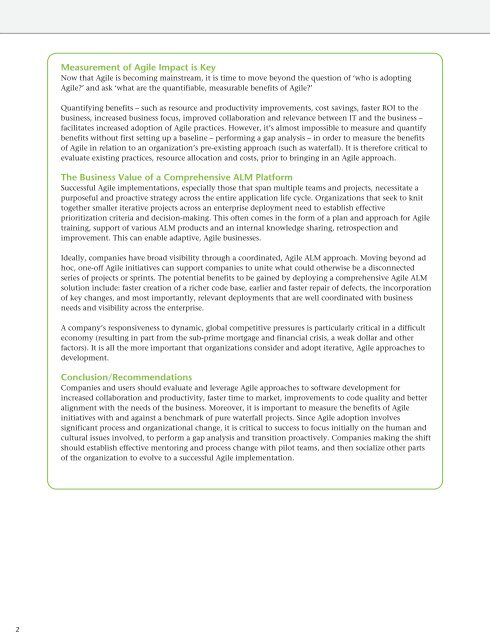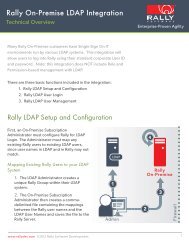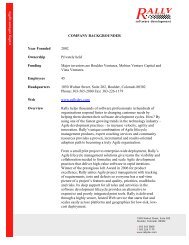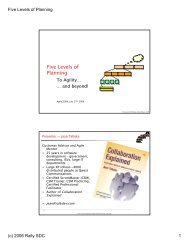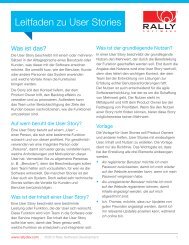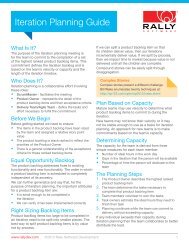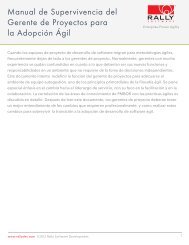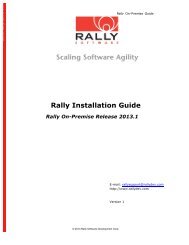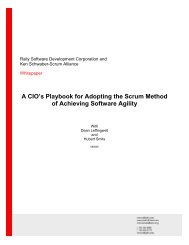The Agile Impact Report - Rally Software
The Agile Impact Report - Rally Software
The Agile Impact Report - Rally Software
Create successful ePaper yourself
Turn your PDF publications into a flip-book with our unique Google optimized e-Paper software.
Measurement of <strong>Agile</strong> <strong>Impact</strong> is Key<br />
Now that <strong>Agile</strong> is becoming mainstream, it is time to move beyond the question of ‘who is adopting<br />
<strong>Agile</strong>?’ and ask ‘what are the quantifiable, measurable benefits of <strong>Agile</strong>?’<br />
Quantifying benefits – such as resource and productivity improvements, cost savings, faster ROI to the<br />
business, increased business focus, improved collaboration and relevance between IT and the business –<br />
facilitates increased adoption of <strong>Agile</strong> practices. However, it’s almost impossible to measure and quantify<br />
benefits without first setting up a baseline – performing a gap analysis – in order to measure the benefits<br />
of <strong>Agile</strong> in relation to an organization’s pre-existing approach (such as waterfall). It is therefore critical to<br />
evaluate existing practices, resource allocation and costs, prior to bringing in an <strong>Agile</strong> approach.<br />
<strong>The</strong> Business Value of a Comprehensive ALM Platform<br />
Successful <strong>Agile</strong> implementations, especially those that span multiple teams and projects, necessitate a<br />
purposeful and proactive strategy across the entire application life cycle. Organizations that seek to knit<br />
together smaller iterative projects across an enterprise deployment need to establish effective<br />
prioritization criteria and decision-making. This often comes in the form of a plan and approach for <strong>Agile</strong><br />
training, support of various ALM products and an internal knowledge sharing, retrospection and<br />
improvement. This can enable adaptive, <strong>Agile</strong> businesses.<br />
Ideally, companies have broad visibility through a coordinated, <strong>Agile</strong> ALM approach. Moving beyond ad<br />
hoc, one-off <strong>Agile</strong> initiatives can support companies to unite what could otherwise be a disconnected<br />
series of projects or sprints. <strong>The</strong> potential benefits to be gained by deploying a comprehensive <strong>Agile</strong> ALM<br />
solution include: faster creation of a richer code base, earlier and faster repair of defects, the incorporation<br />
of key changes, and most importantly, relevant deployments that are well coordinated with business<br />
needs and visibility across the enterprise.<br />
A company’s responsiveness to dynamic, global competitive pressures is particularly critical in a difficult<br />
economy (resulting in part from the sub-prime mortgage and financial crisis, a weak dollar and other<br />
factors). It is all the more important that organizations consider and adopt iterative, <strong>Agile</strong> approaches to<br />
development.<br />
Conclusion/Recommendations<br />
Companies and users should evaluate and leverage <strong>Agile</strong> approaches to software development for<br />
increased collaboration and productivity, faster time to market, improvements to code quality and better<br />
alignment with the needs of the business. Moreover, it is important to measure the benefits of <strong>Agile</strong><br />
initiatives with and against a benchmark of pure waterfall projects. Since <strong>Agile</strong> adoption involves<br />
significant process and organizational change, it is critical to success to focus initially on the human and<br />
cultural issues involved, to perform a gap analysis and transition proactively. Companies making the shift<br />
should establish effective mentoring and process change with pilot teams, and then socialize other parts<br />
of the organization to evolve to a successful <strong>Agile</strong> implementation.<br />
2


